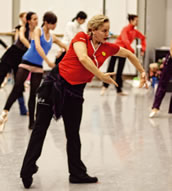|
|
Hintergrund The Invisible Labor of Ballet MastersThe Unsung Backbone of Performance: A Ballet Master’s Perspectiveby Laura Graham After 26 years working in German Theaters and 51 years serving our art-form, I’ve witnessed profound transformations in our profession – yet one constant remains: the ballet master’s role is critically misunderstood and systematically undervalued. Whether leading rehearsals in a small group or a large company, ballet masters face similar challenges and the complexity of our work remains consistent. We are the organizational glue holding performance ecosystems together, bridging dancers, artistic directors, technical departments and guest choreographers. The majority of our tasks are not artistic, but one needs a high-level of artistic experience to do the job. Ballettmeisterin Laura Graham beim Staging, „Artifact Suite“ von William Forsythe. Our work extends far beyond choreographic transmission. A typical season demands managing dancers across multiple programs of wide ranging performance styles, requiring extraordinary logistical and artistic precision. We spend countless hours documenting, filming, transcribing and archiving oftentimes outside of our work hours – skills rarely acknowledged in traditional performance narratives. A single rehearsal might compress three hours of potential work into a single hour, demanding hyper-efficient planning with an almost supernatural ability to communicate nuanced artistic vision at the same time. In real terms, these preparations can take from two to three hours daily and expand to seven or more hours if learning new ballets to teach and stage. This is of course outside of the 44-hours-6-days week theatre schedule. This is a regular weekly minimum of 58 up to 65 hours of work. The Hidden ChallengesOur profession can harbour a painful, often unspoken reality. Many ballet masters carry stories of disrespect – experiences of exploitation, emotional gaslighting, burnout and sometimes outright discrimination. Many professionals feel unable to speak out for fear of professional repercussions. Most critically unrecognized is the emotional labor. We are confidants, mentors, and psychological support systems for dancers navigating intense professional pressures. Our role requires not just technical mastery, but profound empathy and interpersonal intelligence. The organizational dynamics of German theatre structures present particularly complex challenges for ballet masters. Despite being essential to artistic productions, ballet masters often find themselves institutionally marginalized, “wearing many hats” with limited formal advocacy or structural support. These topics are just a tip of the iceberg. A Call to CommunityTo my fellow ballet masters: You are not alone! Your experiences, challenges and insights matter profoundly. This article is an invitation, a safe space to share, to connect and to collectively illuminate our vital role in the performing arts. If you wish to join this dialogue, share your story or find support, please reach out and send an Email to joerg.loewer@vdoper.de. Our strength lies in our solidarity, our shared passion, and our unwavering commitment to the art form we love. I would love to speak more about it. |
|
|
|
© by Oper &
Tanz 2000 ff. |


